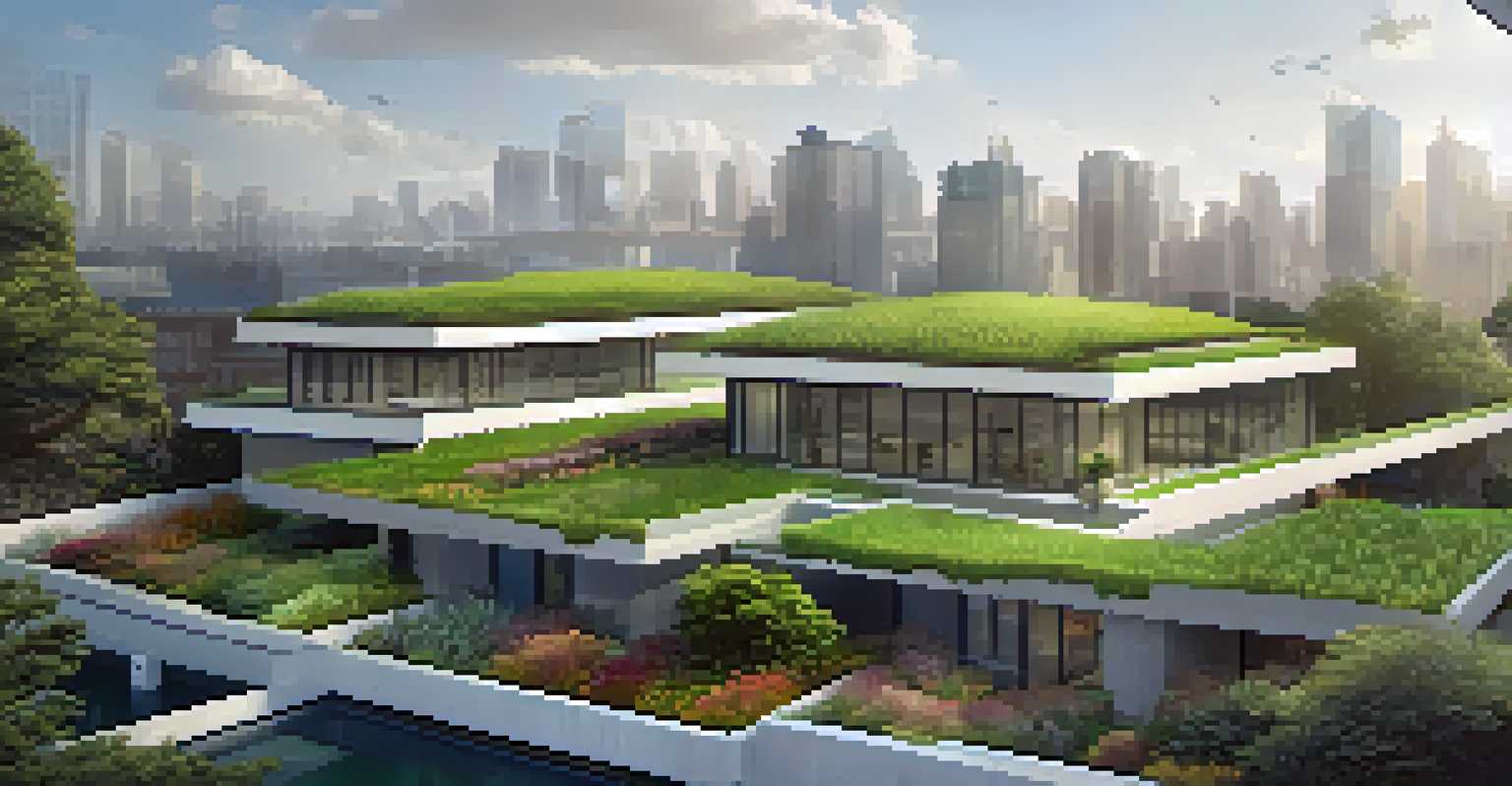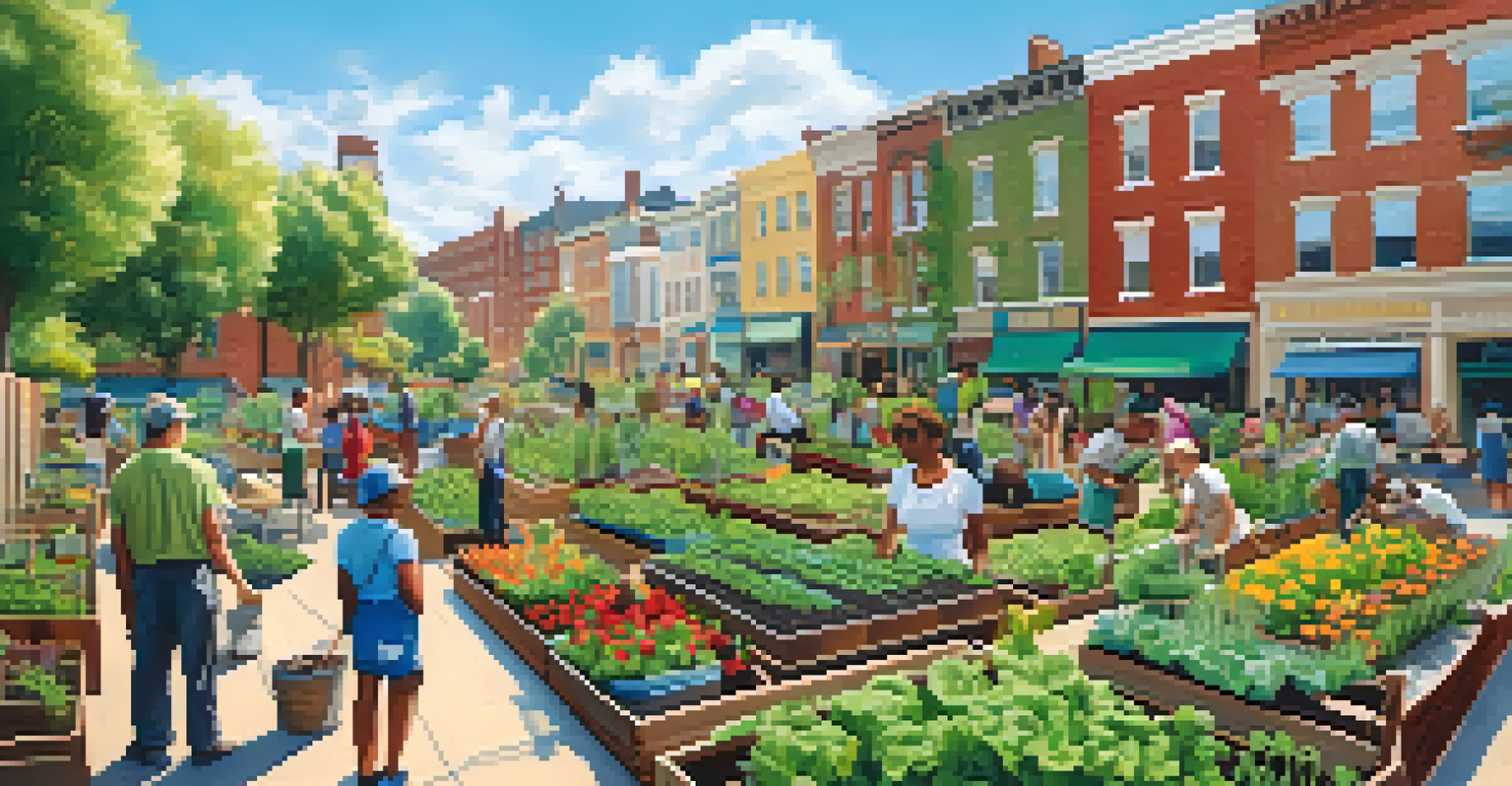The Role of Green Infrastructure in Urban Sustainability Goals

Understanding Green Infrastructure and Its Importance
Green infrastructure refers to a network of natural and semi-natural systems that provide environmental benefits, such as clean air and water. Unlike traditional infrastructure, which often focuses solely on concrete and steel, green infrastructure integrates nature into urban planning. This approach not only enhances the aesthetic value of cities but also addresses critical issues like flooding, heat islands, and air pollution.
Nature does not hurry, yet everything is accomplished.
For instance, green roofs and walls can reduce energy consumption while absorbing rainwater, which helps manage stormwater runoff. Urban parks serve as lungs for cities, improving air quality and offering recreational spaces for residents. By weaving nature into the urban fabric, cities can become more resilient and adaptable to climate change challenges.
In essence, green infrastructure plays a pivotal role in urban sustainability, creating a balance between development and ecological stewardship. It emphasizes the importance of preserving natural ecosystems while promoting urban growth. As cities continue to expand, understanding and implementing green infrastructure will be essential for achieving long-term sustainability goals.
Key Benefits of Green Infrastructure in Cities
One of the most significant benefits of green infrastructure is its ability to enhance biodiversity in urban areas. By integrating green spaces, cities provide habitats for various species, which can help restore ecological balance. This not only enhances urban environments but also contributes to the overall health of our planet.

Moreover, green infrastructure can lead to economic advantages. For example, areas with ample green spaces often see increased property values, attracting businesses and residents alike. This influx can stimulate local economies, creating jobs and fostering community development, which is a win-win scenario for urban planners.
Green Infrastructure Enhances Cities
Integrating nature into urban planning improves environmental quality, aesthetic appeal, and resilience against climate challenges.
Lastly, these green systems can improve public health outcomes. Access to parks and green spaces encourages physical activity, reduces stress, and enhances mental well-being. By prioritizing green infrastructure, cities can create healthier environments that promote a better quality of life for their citizens.
Integrating Green Infrastructure into Urban Planning
To effectively integrate green infrastructure into urban planning, collaboration among various stakeholders is crucial. This includes city planners, architects, environmentalists, and the community. By working together, they can identify opportunities to incorporate green solutions that meet both ecological and social needs.
The best time to plant a tree was twenty years ago. The second best time is now.
For instance, community gardens can be established in vacant lots, turning underutilized spaces into productive areas that foster social interaction. Additionally, integrating green corridors can connect parks and natural areas, promoting wildlife movement and enhancing urban biodiversity. This collaborative approach ensures that green infrastructure is tailored to the unique needs of each area.
Furthermore, cities can adopt policies that prioritize green infrastructure investments. This might include incentives for developers to include green roofs or permeable pavements in their projects. By formalizing these strategies, urban planners can create a more sustainable framework that encourages the adoption of green practices across the city.
Challenges in Implementing Green Infrastructure
Despite its numerous benefits, implementing green infrastructure is not without challenges. One major hurdle is the initial cost of installation and maintenance. Many cities operate under budget constraints, which can make it difficult to allocate funds for green projects, especially when immediate infrastructure needs are pressing.
Additionally, there may be a lack of awareness or understanding among community members and decision-makers about the long-term benefits of green infrastructure. This can lead to resistance or skepticism regarding its implementation. Education and outreach efforts are vital to showcase successful case studies and demonstrate the value of investing in green solutions.
Collaboration is Key to Success
Effective integration of green infrastructure requires collaboration among city planners, architects, and the community to address ecological and social needs.
Finally, spatial constraints in densely populated urban areas might limit the opportunities for integrating green infrastructure. However, innovative design solutions, such as vertical gardens or green roofs, can help overcome these limitations. By rethinking space usage, cities can still incorporate green elements into their landscapes.
Case Studies: Successful Green Infrastructure Projects
Several cities around the world have successfully implemented green infrastructure, offering valuable lessons for others. For example, Singapore is renowned for its extensive green roofs and vertical gardens, transforming its urban environment into a lush, green oasis. The city has demonstrated that integrating nature can enhance urban livability while addressing environmental challenges.
Another notable case is New York City, which has embraced green infrastructure through initiatives like the MillionTreesNYC campaign. This effort aimed to plant one million trees across the city, improving air quality and providing shade. The project not only beautified neighborhoods but also contributed to reducing the urban heat island effect.
These examples highlight the potential of green infrastructure to drive positive change in urban settings. By showcasing successful projects, cities can inspire others to adopt similar strategies, ultimately leading to a more sustainable future for urban environments.
The Role of Policy in Promoting Green Infrastructure
Policies play a crucial role in promoting the adoption of green infrastructure in urban areas. Government initiatives can provide funding, resources, and guidelines that encourage cities to invest in sustainable practices. For example, tax incentives for developers who include green features in their buildings can stimulate growth in this area.
Additionally, zoning regulations can be modified to incorporate green infrastructure requirements, such as green roofs or rain gardens in new developments. These policies can help create a framework that prioritizes environmental considerations while still allowing for urban expansion. By aligning regulations with sustainability goals, cities can foster a culture of green infrastructure.
Policy Drives Green Investment
Government policies and incentives are essential for encouraging the adoption of green infrastructure practices in urban development.
Moreover, public engagement in policy-making can enhance the effectiveness of these initiatives. Involving community members in discussions about green infrastructure can lead to better-informed policies that reflect local needs. This participatory approach ensures that the voices of residents are heard, fostering a sense of ownership and commitment to sustainable urban development.
Future Trends in Green Infrastructure Development
As urban areas continue to grow, the future of green infrastructure looks promising. One emerging trend is the use of technology to enhance green solutions. Smart sensors can be integrated into green systems to monitor environmental conditions, allowing for more effective management of resources like water and energy.
Another trend is the increasing focus on community-driven initiatives. Residents are becoming more involved in the planning and maintenance of green spaces, fostering a sense of pride and responsibility. This grassroots approach can lead to more sustainable practices, as communities take ownership of their environment and advocate for its preservation.

Lastly, climate resilience is becoming a central theme in green infrastructure development. As cities face the impacts of climate change, there’s a growing recognition of the need for adaptable and flexible green solutions. This forward-thinking mindset will ensure that urban areas are equipped to handle future challenges while promoting sustainability.